
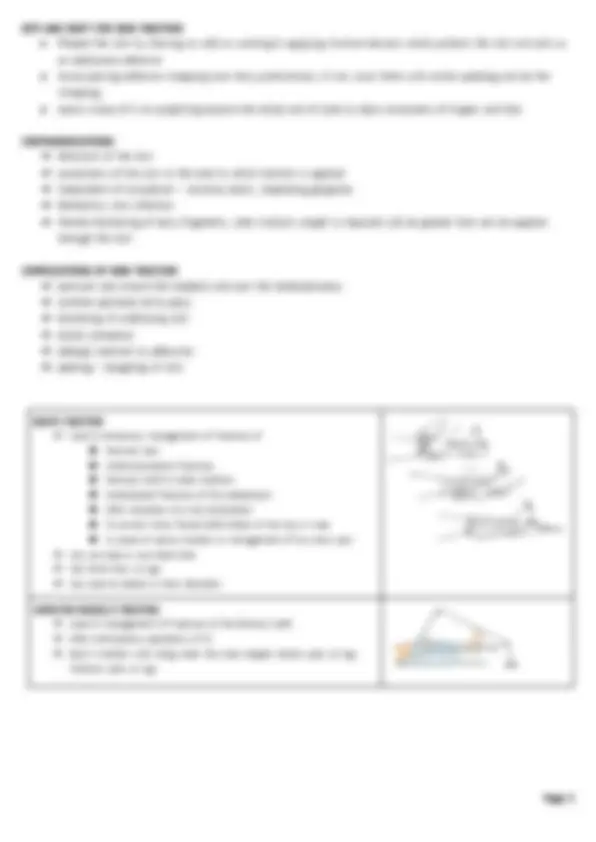
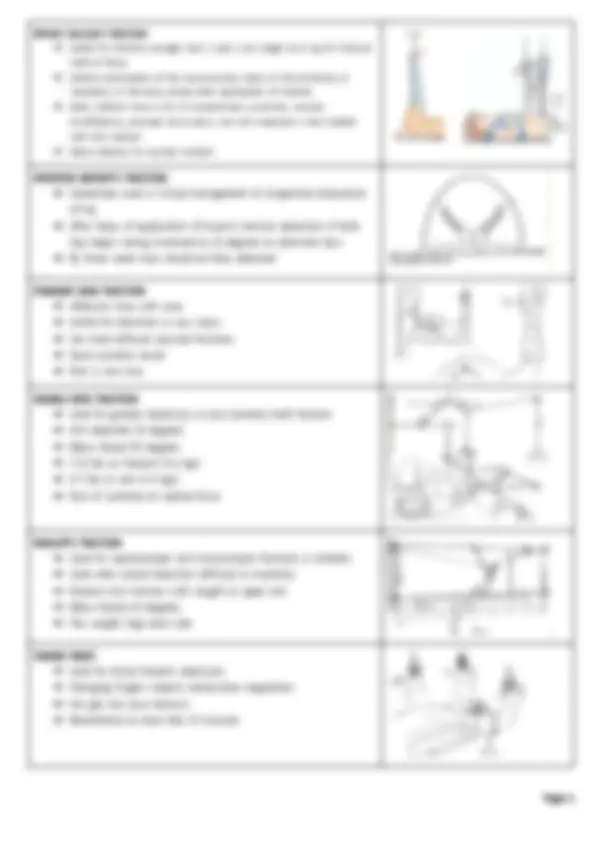
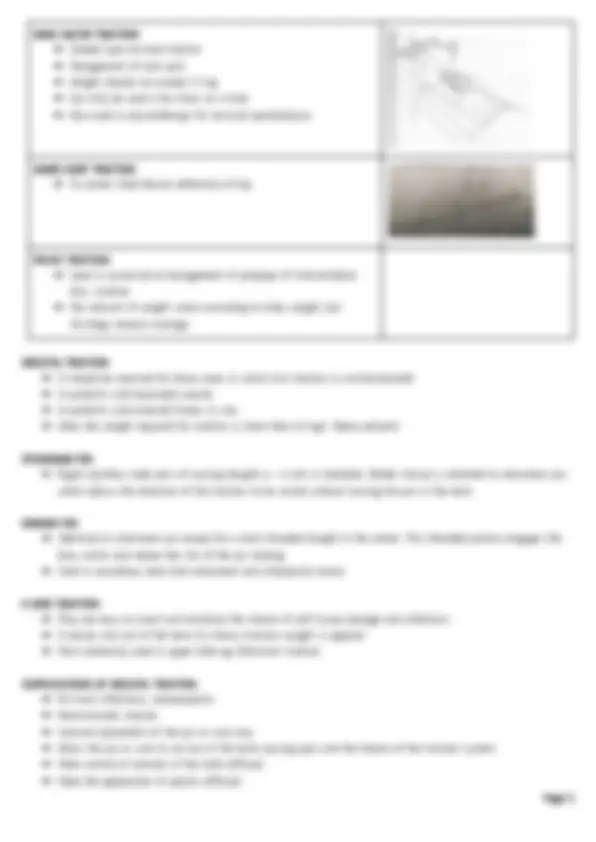
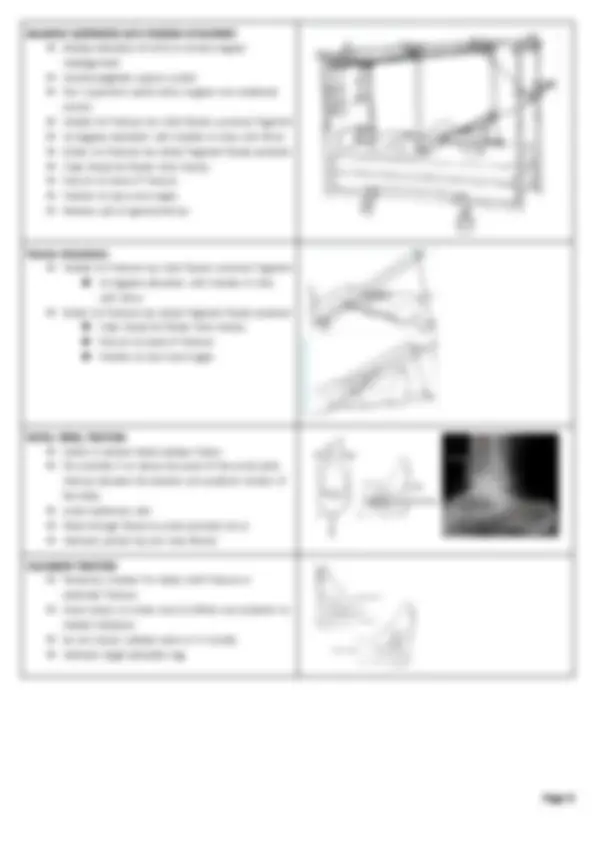
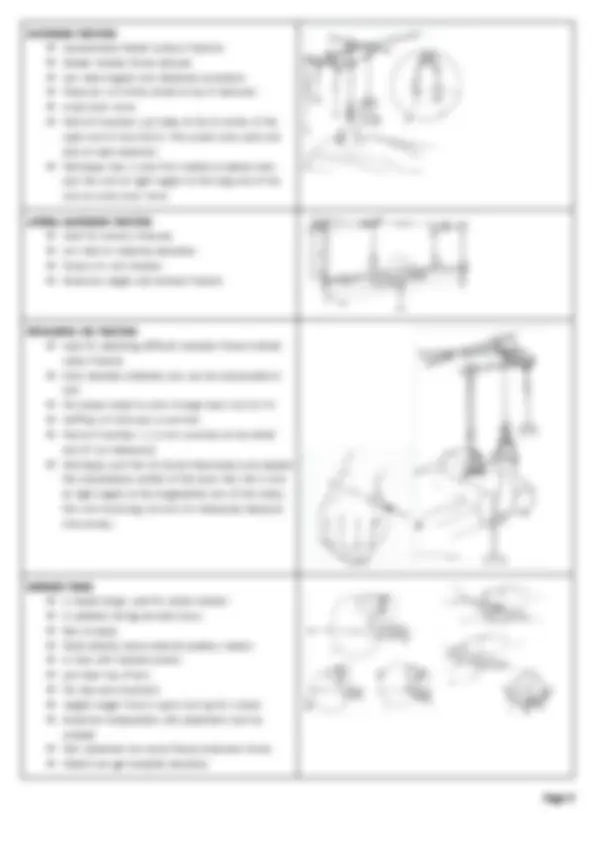
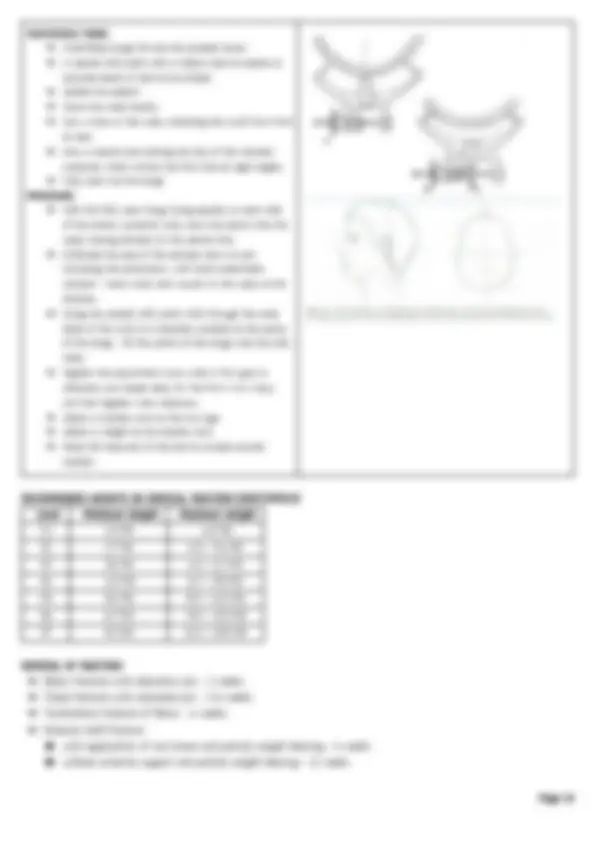


Study with the several resources on Docsity

Earn points by helping other students or get them with a premium plan


Prepare for your exams
Study with the several resources on Docsity

Earn points to download
Earn points by helping other students or get them with a premium plan
Community
Ask the community for help and clear up your study doubts
Discover the best universities in your country according to Docsity users
Free resources
Download our free guides on studying techniques, anxiety management strategies, and thesis advice from Docsity tutors
Traction is used in Orthopedics
Typology: Cheat Sheet
1 / 10

This page cannot be seen from the preview
Don't miss anything!







➔ is a force applied manually or mechanically generated by weights or force, used to reduce fractures / dislocations or to achieve relative immobilization USES ➔ to reduce fracture/ dislocation by counteracting muscle spasm ➔ to relieve pain by relative immobilisation and relieving spasm ➔ to keep joint surfaces apart in inflammatory conditions like septic/ tubercular arthritis. HISTORY ● Skin traction used extensively in Civil War for fractured femurs ● Known as the “American Method” ● Hippocrates- treated fracture shaft of femur and of leg with the leg straight in extension ● Guy de Chauliac- introduced continuous isotonic traction in the fracture of femur ● Percival Pott- fractured limb should be placed in the position in which muscles are most relaxed ● Josiah Crosby – isotonic skin traction for treatment of shaft of femur ● Thomas Bryant- Braynt’s traction for treatment of fracture shaft of femur in children ● Malgaigne introduced the1st effective traction which grasped the bone itself. He used malgaigne’s hooks ● Fritz-Steinmann introduced a method of applying skeletal traction to the femur by means of two pins driven into the femoral condyles ● Lorenz-Bohler – ‘The Father of Traumatology’ popularised skeletal traction by means of steinmann pins after he devised Bohler stirrup INDICATION ➔ Lessen or eliminate muscle spasms ➔ Relieve pressure on nerves, especially spinal ➔ ToIncrease space between opposing surfaces ➔ Prevent or reduce skeletal deformities or muscle contractures ➔ To provide a fusiform tamponade around a bleeding vessel ADVANTAGES ➔ Decrease pain ➔ Minimize muscle spasms ➔ Reduces, aligns, and immobilizes fractures ➔ Reduce deformity
➔ Hazards of prolonged bed rest ➔ Thromboembolism ➔ Decubitus ulcers ➔ Pneumonia ➔ Requires meticulous nursing care ➔ Can develop contractures CLASSIFICATION ➔ CLASSIFICATION I ◆ Skin Traction– traction is applied through skin by adhesive bandage/bandage foam construct ◆ Skeletal Traction– traction is applied to bone using steinmann pin / k – wires ◆ Manual Traction ➔ CLASSIFICATION II ◆ Balanced Traction– uses gravity for counter-traction ◆ Fixed Traction– traction is given between two fixed points SLIDING TRACTION ➔ Introduced by Pugh, treatment of perthes ➔ One limb is tightened via skin traction and fastened to the end of bed, the bed is then raised head down, enabling the pelvis on the opposite side to slide down in traction and abduction
➔ The amount of traction can thus be changed by friction of mattress ➔ Hendry modified the traction by using a sliding fracme on the mattress FACTORS ● Type of traction ● Amount of weight to be applied ● Frequency of neurovascular checks if more frequent than every four hours ● Site care of inserted pins, wires, or tongs ● The site and care of straps, harnesses and halters ● The inclusion of any other physical restraints / straps or appliances (e.g., mouth guard) ● The discontinuation of traction COMPONENTS ➔ CORD ◆ Sash cord generally used, nylon cord can also be used ◆ Easier recognition of each cord is possible if cords of two different colours used ➔ PULLEYS ◆ To control the direction of weight ◆ By altering site and by using more than 1 pulley the force exerted by a given weight can be increased ◆ Pulleys of 5-6.25cm diameter with 6cm diameter axles are preferred. ➔ KNOTS SKIN TRACTION ➔ Applied over a large area of skin ➔ This spreads the load and is more comfortable and efficient ➔ Traction force must be applied distal to fracture site ➔ Maximum traction weight can be applied with skin traction is 15lb ( 6.7kg ) ➔ Two types Adhesive skin traction Nonadhesive skin traction
BRYANT GALLOW’S TRACTION ➔ Useful for children younger than 2 years who weigh 10-12 kg for Fracture shaft of femur ➔ Careful examination of the neurovascular status of the extremity is mandatory in the early period after application of traction ➔ Older children have a risk of compartment syndrome, vascular insufficiency, peroneal nerve palsy, and skin breakdown when treated with this method ➔ Raise mattress for counter traction MODIFIED BRYANT’S TRACTION ➔ Sometimes used in initial management of congenital dislocation of hip ➔ After 5days of application of bryants traction abduction of both hips begin, being increased by 10 degrees on alternate days ➔ By three weeks hips should be fully abducted FOREARM SKIN TRACTION ➔ Adhesive strip with wrap ➔ Useful for elevation in any injury ➔ Can treat difficult clavicle fractures ➔ Good cosmetic result ➔ Risk is skin loss DOUBLE SKIN TRACTION ➔ Used for greater tuberosity or prox humeral shaft fracture ➔ Arm abducted 30 degrees ➔ Elbow flexed 90 degrees ➔ 7-10 lbs on forearm (3-4 kgs) ➔ 5-7 lbs on arm (2-3 kgs) ➔ Risk of ischemia at cubital fossa DUNLOP’S TRACTION ➔ Used for supracondylar and transcondylar fractures in children ➔ Used when closed reduction difficult or traumatic ➔ Forearm skin traction with weight on upper arm ➔ Elbow flexed 45 degrees ➔ Max weight 2kgs each side FINGER TRAPS ➔ Used for distal forearm reductions ➔ Changing fingers imparts radial/ulnar angulation ➔ Can get skin loss/necrosis ➔ Recommend no more than 20 minutes
➔ Simple type cervical traction ➔ Management of neck pain ➔ Weight should not exceed 2.3 kg ➔ Can only be used a few hours at a time ➔ Also used in physiotherapy for cervical spondylolysis AGNES HUNT TRACTION ➔ To correct mild flexion deformity of hip PELVIC TRACTION ➔ Used in conservative management of prolapse of intervertebral disc, sciatica ➔ Max amount of weight varies according to body weight, but 30-45kgs remains average SKELETAL TRACTION ➔ It should be reserved for those cases in which skin traction is contraindicated ➔ In patients with lacerated wounds ➔ In patients with external fixator in situ ➔ When the weight required for traction is more then 6.5 kgs- Obese patients STEINMANN PIN ➔ Rigid stainless steel pins of varying lengths 4 – 6 mm in diameter. Bohler stirrup is attached to steinmann pin which allows the direction of the traction to be varied without turning the pin in the bone DENHAM PIN ➔ Identical to stienmann pin except for a short threaded length in the center. This threaded portion engages the bony cortex and reduce the risk of the pin sliding ➔ Used in cancellous bone like calcaneum and osteoporitic bones K WIRE TRACTION ➔ They are easy to insert and minimize the chance of soft tissue damage and infections ➔ It easily cuts out of the bone if a heavy traction weight is applied ➔ Most commonly used in upper limb eg. Olecranon traction COMPLICATIONS OF SKELETAL TRACTION ➔ Pin tract infections, osteomyelitis ➔ Neurovascular injuries ➔ Incorrect placement of the pin or wire may ➔ Allow the pin or wire to cut out of the bone causing pain and the failure of the traction system ➔ Make control of rotation of the limb difficult ➔ Make the application of splints difficult
NINETY NINETY TRACTION ➔ Useful for subtrochantric and proximal 3rd femur fracture ➔ Especially in young children ➔ Matches flexion of proximal fragment ➔ Can cause flexion contracture in adult PERKIN’S TRACTION ➔ Treatment of fractures of tibia and of the femur from the subtrochantric region distally ➔ Basis of management is the use of skeletal traction coupled with active movements of the injured limb ➔ By encouraging early muscular activity, the development of stiff joint is frequently prevented by both maintaining extensibility of muscles by reciprocal innervation, and preventing stagnation of tissue fluid ➔ A Hadfield split bed is required ➔ Under General anaesthesia and full aseptic conditions, a Denham pin is inserted through the upper end of tibia ➔ A Simonis swivel is attached to end of each Denham pin ➔ Two traction cords are connected to each of swivel ➔ 4.6 kg weight is attached to each traction cord making a total traction weight of 9.2 kg ➔ Foot end of the bed is elevated by one inch for each 0.46 kg of traction weight ➔ One or more pillow is placed under the thigh to maintain the anterior bowing of the femoral shaft ➔ Length of the limb is checked with a tape measure and total traction weight is increased or decreased as necessary ➔ Active Quadriceps exercises are started immediately and continued ➔ Knee flexion is started after a week of admission, under supervision
BALANCED SUSPENSION WITH PEARSON ATTACHMENT ➔ Enables elevation of limb to correct angular malalignment ➔ Counterweighted support system ➔ Four suspension points allow angular and rotational control ➔ Middle 3rd fracture has mild flexion proximal fragment ➔ 30 degrees elevation with traction in line with femur ➔ Distal 3rd fracture has distal fragment flexed posterior ➔ Knee should be flexed more sharply ➔ Fulcrum at level of fracture ➔ Traction at downward angle ➔ Reduces pull of gastrocnemius Pearson Attachment ➔ Middle 3rd fracture has mild flexion proximal fragment ◆ 30 degrees elevation with traction in line with femur ➔ Distal 3rd fracture has distal fragment flexed posterior ◆ Knee should be flexed more sharply ◆ Fulcrum at level of fracture ◆ Traction at downward angle DISTAL TIBIAL TRACTION ➔ Useful in certain tibial plateau fractur ➔ Pin inserted 5 cm above the level of the ankle joint, midway between the anterior and posterior borders of the tibia ➔ Avoid saphenous vein ➔ Place through fibula to avoid peroneal nerve ➔ Maintain partial hip and knee flexion CALCANEUM TRACTION ➔ Temporary traction for tibial shaft fracture or calcaneal fracture ➔ Insert about 1.5 inches (4cms) inferior and posterior to medial malleolus ➔ Do not skewer subtalar joint or NV bundle ➔ Maintain slight elevation leg
CRUTCHFIELD TONGS ➔ Crutchfield tongs fit into the parietal bones ➔ A special drill point with a sleeve used to enable an accurate depth of hole to be drilled ➔ Sedate the patient ➔ Shave the scalp locally ➔ Draw a line on the scalp, bisecting the skull from front to back ➔ Draw a second line joining the tips of the mastoid processes which crosses the first line at right angles ➔ Fully open out the tongs PROCEDURE: ➔ With the fully open tongs lying equally on each side of the antero- posterior line, press the points into the scalp making dimples on the second line. ➔ Infiltrate the area of the dimples down to and including the periosteum, with local anaesthetic solution. Make small stab wounds in the scalp at the dimples. ➔ Using the special drill point, drill through the outer table of the skull in a direction parallel to the points of the tongs. Fit the points of the tongs into the drill holes ➔ Tighten the adjustment screw until a firm grip is obtained, and repeat daily for the first 3 to 4 days, and then tighten when necessary ➔ Attach a traction cord to the two lugs ➔ Attach a weight to the traction cord ➔ Raise the head end of the bed to provide counter traction RECOMMENDED WEIGHTS IN CERVICAL TRACTION (CRUTCHFIELD) Level Minimum Weight Maximum Weight C1 2.3 KG 4.5 KG C2 2.7 KG 4.5 – 5.4 KG C3 3.6 KG 4.5 – 6.7 KG C4 4.5 KG 6.7 – 9.0 KG C5 5.4 KG 9.0 – 11.3 KG C6 6.7 KG 9.0 – 13.5 KG C7 8.2 KG 11.3 – 15.8 KG REMOVAL OF TRACTION ➔ Elbow fracture with olecranon pin - 3 weeks ➔ Tibial fracture with calcaneal pin - 3-6 weeks ➔ Trochanteric fracture of femur - 6 weeks ➔ Femoral shaft fracture ◆ with application of cast brace and partial weight bearing - 6 weeks ◆ without external support and partial weight bearing - 12 weeks